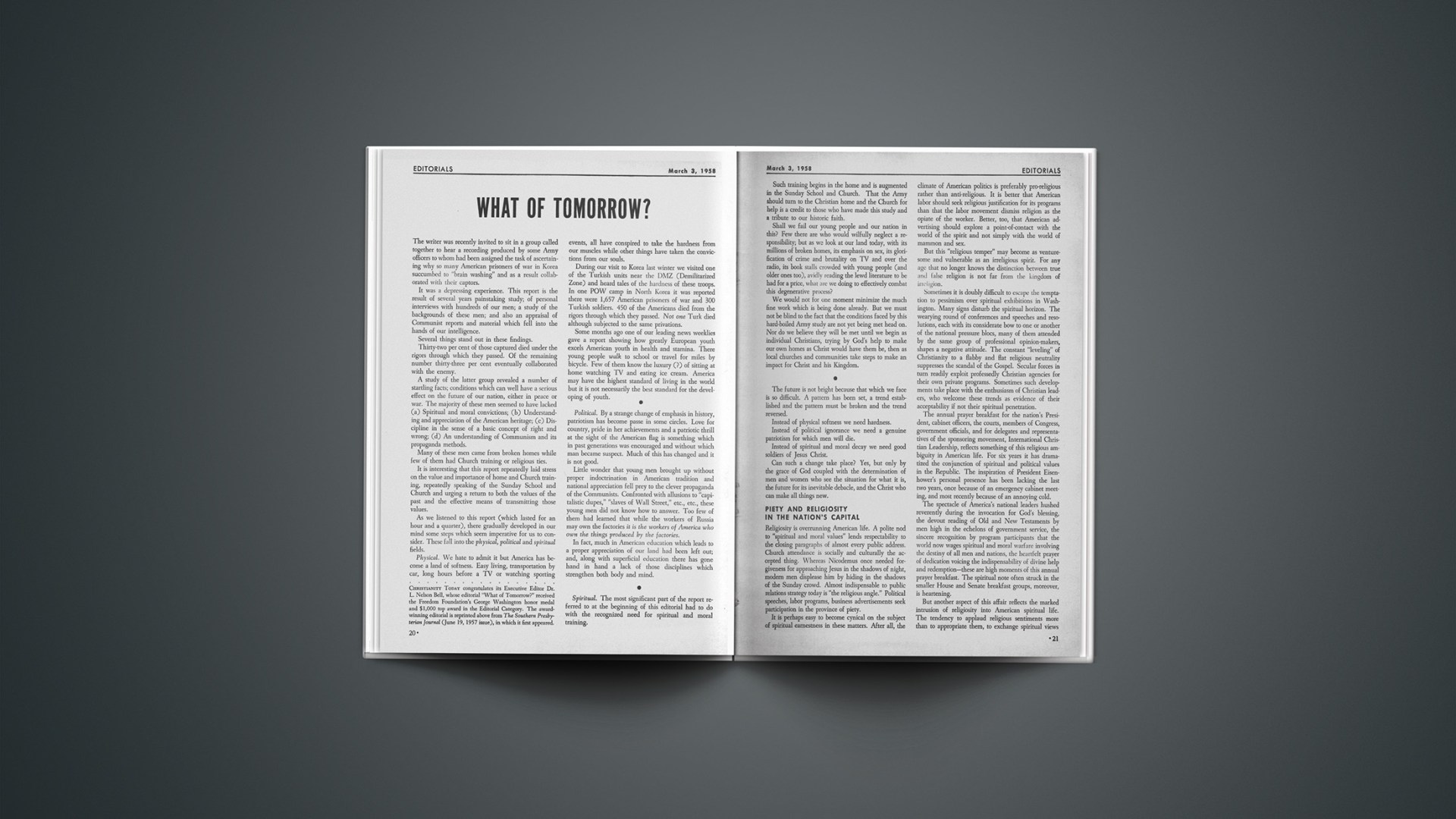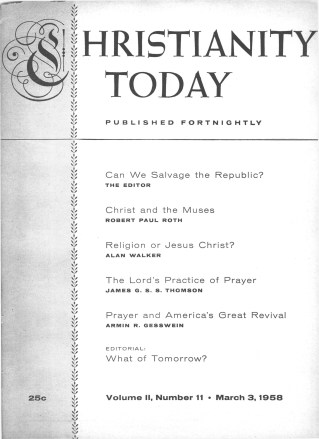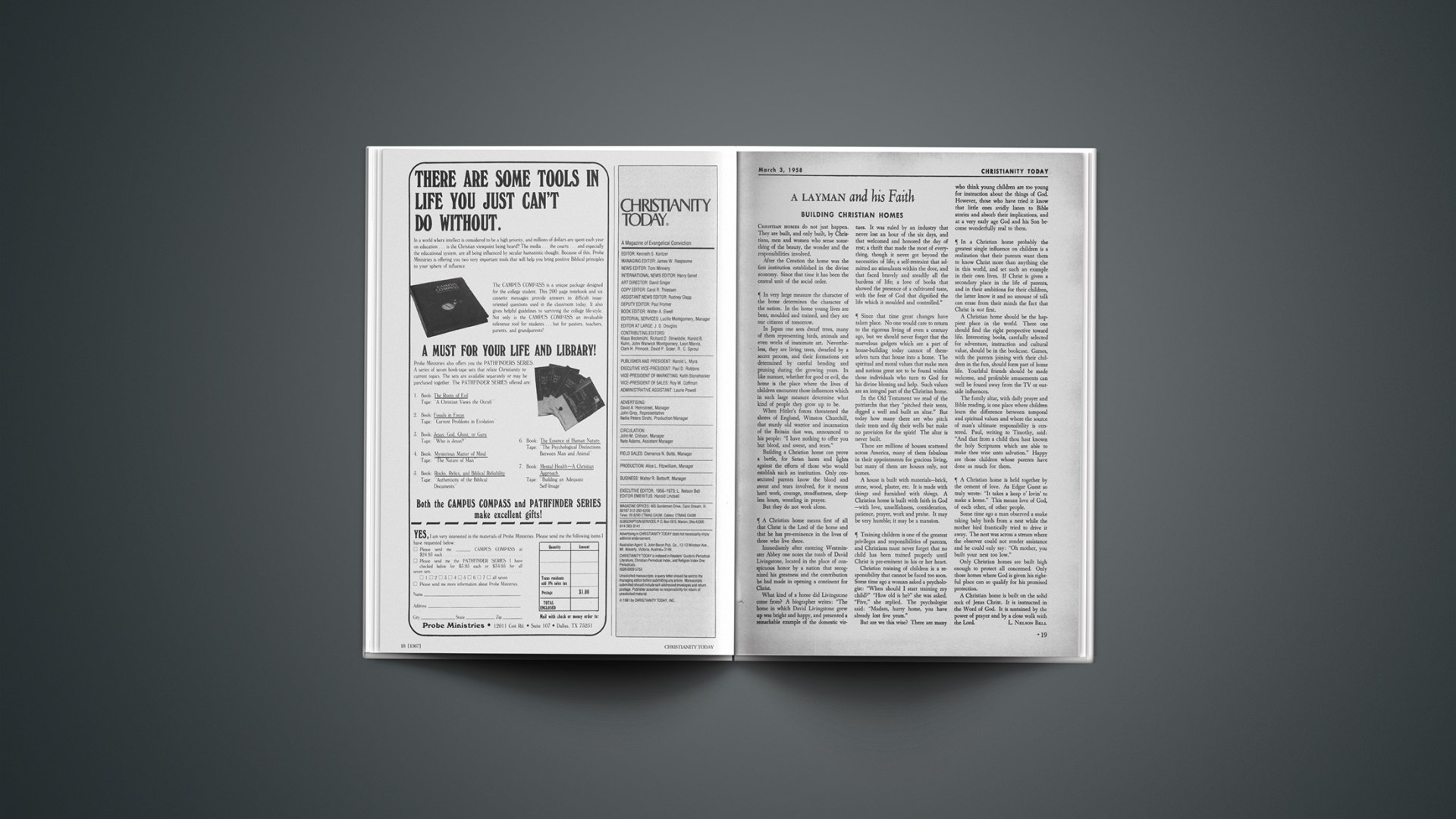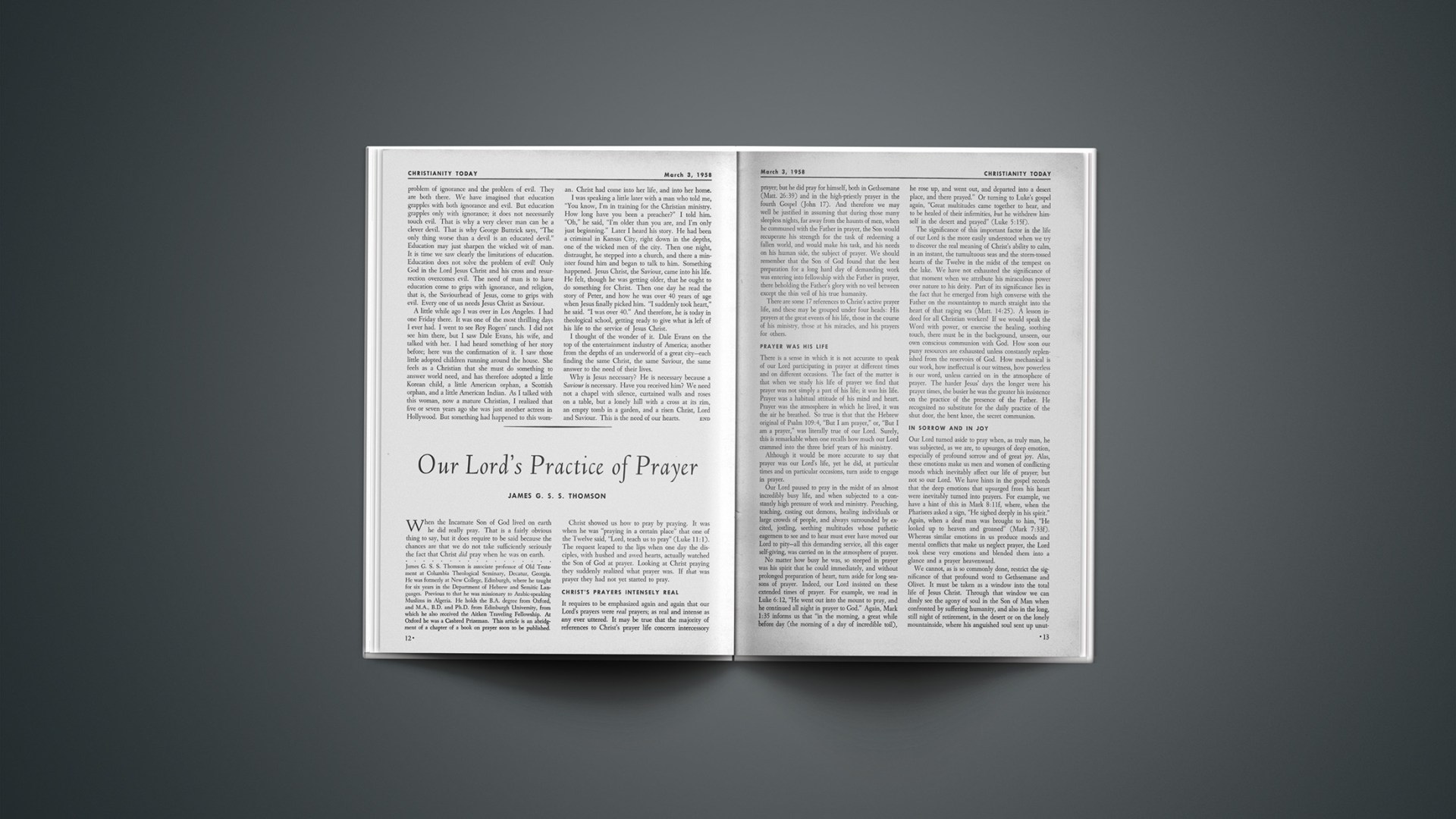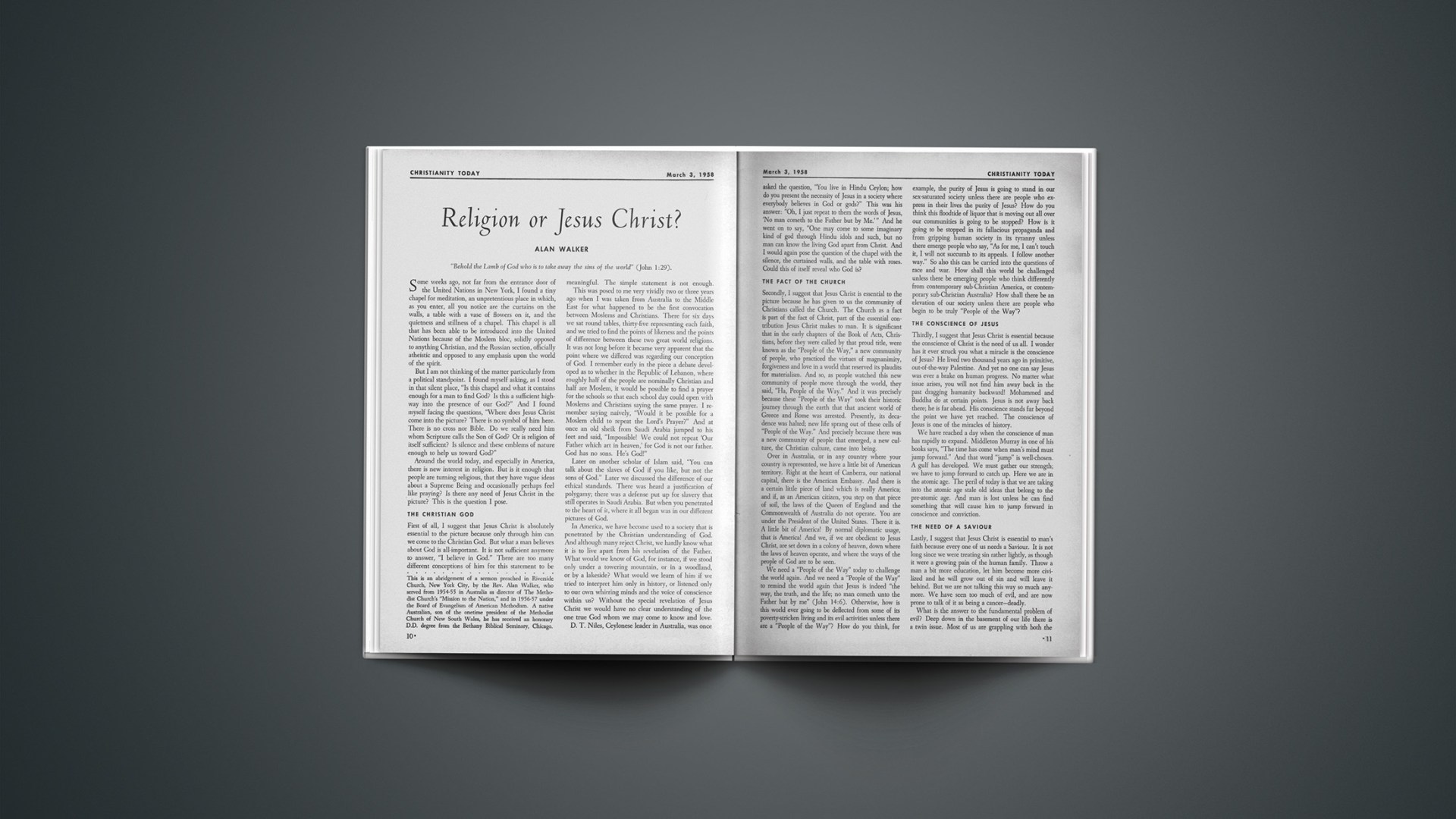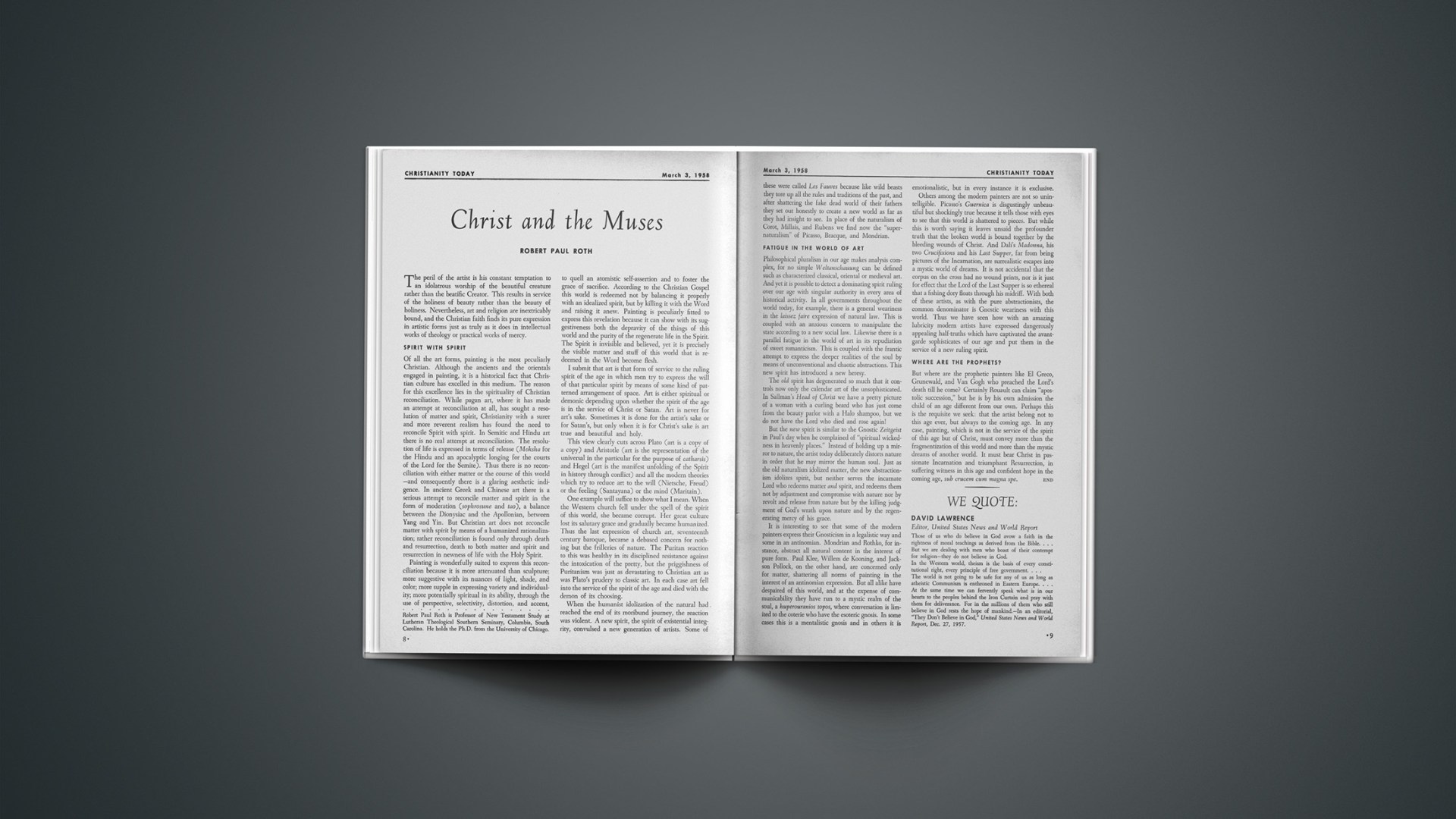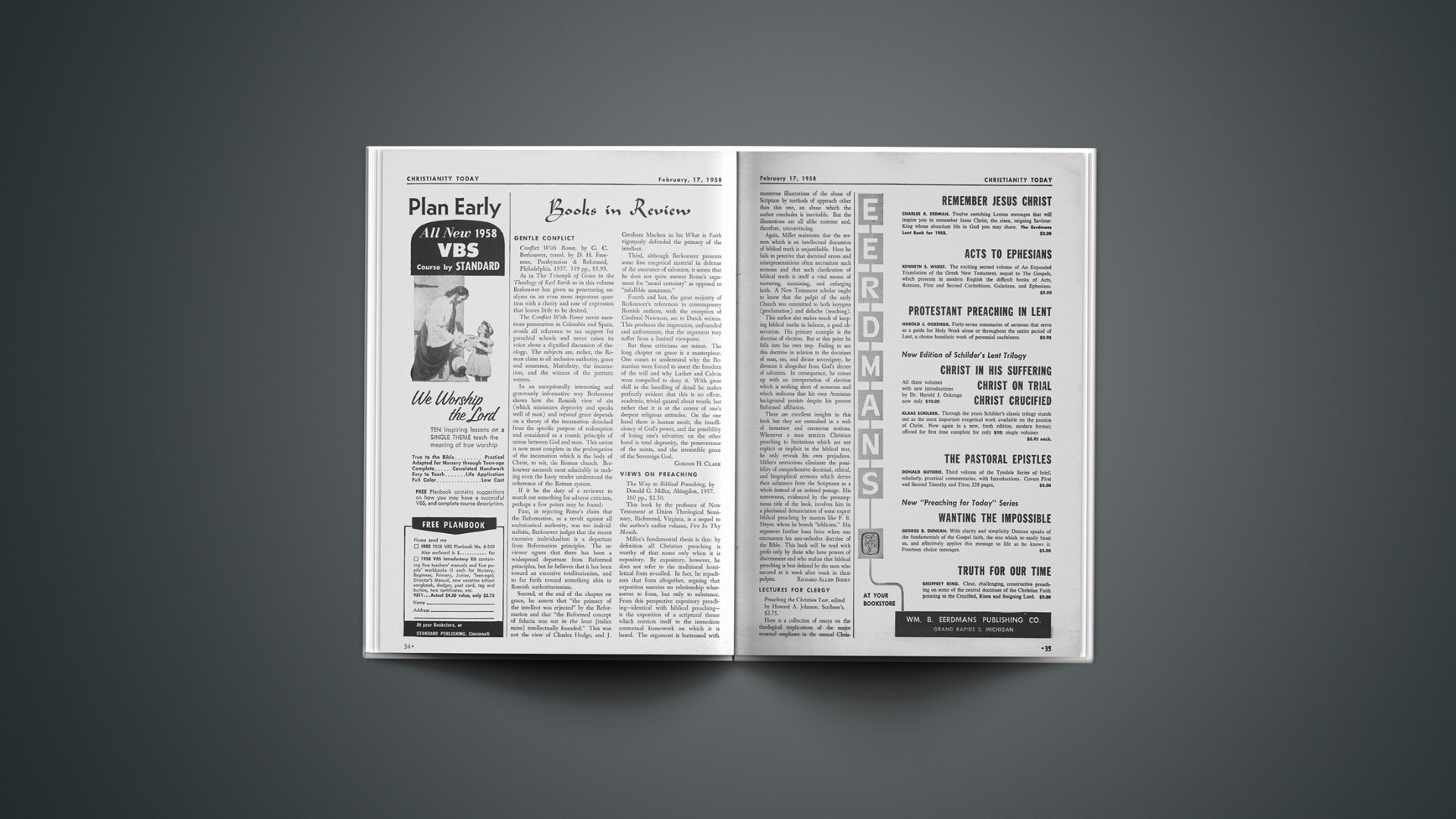The writer was recently invited to sit in a group called together to hear a recording produced by some Army officers to whom had been assigned the task of ascertaining why so many American prisoners of war in Korea succumbed to “brain washing” and as a result collaborated with their captors.
It was a depressing experience. This report is the result of several years painstaking study; of personal interviews with hundreds of our men; a study of the backgrounds of these men; and also an appraisal of Communist reports and material which fell into the hands of our intelligence.
Several things stand out in these findings.
Thirty-two per cent of those captured died under the rigors through which they passed. Of the remaining number thirty-three per cent eventually collaborated with the enemy.
A study of the latter group revealed a number of startling facts; conditions which can well have a serious effect on the future of our nation, either in peace or war. The majority of these men seemed to have lacked (a) Spiritual and moral convictions; (b) Understanding and appreciation of the American heritage; (c) Discipline in the sense of a basic concept of right and wrong; (d) An understanding of Communism and its propaganda methods.
Many of these men came from broken homes while few of them had Church training or religious ties.
It is interesting that this report repeatedly laid stress on the value and importance of home and Church training, repeatedly speaking of the Sunday School and Church and urging a return to both the values of the past and the effective means of transmitting those values.
As we listened to this report (which lasted for an hour and a quarter), there gradually developed in our mind some steps which seem imperative for us to consider. These fall into the physical, political and spiritual fields.
Physical. We hate to admit it but America has become a land of softness. Easy living, transportation by car, long hours before a TV or watching sporting events, all have conspired to take the hardness from our muscles while other things have taken the convictions from our souls.
During our visit to Korea last winter we visited one of the Turkish units near the DMZ (Demilitarized Zone) and heard tales of the hardness of these troops. In one POW camp in North Korea it was reported there were 1,657 American prisoners of war and 300 Turkish soldiers. 450 of the Americans died from the rigors through which they passed. Not one Turk died although subjected to the same privations.
Some months ago one of our leading news weeklies gave a report showing how greatly European youth excels American youth in health and stamina. There young people walk to school or travel for miles by bicycle. Few of them know the luxury (?) of sitting at home watching TV and eating ice cream. America may have the highest standard of living in the world but it is not necessarily the best standard for the developing of youth.
Political. By a strange change of emphasis in history, patriotism has become passe in some circles. Love for country, pride in her achievements and a patriotic thrill at the sight of the American flag is something which in past generations was encouraged and without which man became suspect. Much of this has changed and it is not good.
Little wonder that young men brought up without proper indoctrination in American tradition and national appreciation fell prey to the clever propaganda of the Communists. Confronted with allusions to “capitalistic dupes,” “slaves of Wall Street,” etc., etc., these young men did not know how to answer. Too few of them had learned that while the workers of Russia may own the factories it is the workers of America who own the things produced by the factories.
In fact, much in American education which leads to a proper appreciation of our land had been left out; and, along with superficial education there has gone hand in hand a lack of those disciplines which strengthen both body and mind.
Spiritual. The most significant part of the report referred to at the beginning of this editorial had to do with the recognized need for spiritual and moral training.
Such training begins in the home and is augmented in the Sunday School and Church. That the Army should turn to the Christian home and the Church for help is a credit to those who have made this study and a tribute to our historic faith.
Shall we fail our young people and our nation in this? Few there are who would wilfully neglect a responsibility; but as we look at our land today, with its millions of broken homes, its emphasis on sex, its glorification of crime and brutality on TV and over the radio, its book stalls crowded with young people (and older ones too), avidly reading the lewd literature to be had for a price, what are we doing to effectively combat this degenerative process?
We would not for one moment minimize the much fine work which is being done already. But we must not be blind to the fact that the conditions faced by this hard-boiled Army study are not yet being met head on. Nor do we believe they will be met until we begin as individual Christians, trying by God’s help to make our own homes as Christ would have them be, then as local churches and communities take steps to make an impact for Christ and his Kingdom.
The future is not bright because that which we face is so difficult. A pattern has been set, a trend established and the pattern must be broken and the trend reversed.
Instead of physical softness we need hardness.
Instead of political ignorance we need a genuine patriotism for which men will die.
Instead of spiritual and moral decay we need good soldiers of Jesus Christ.
Can such a change take place? Yes, but only by the grace of God coupled with the determination of men and women who see the situation for what it is, the future for its inevitable debacle, and the Christ who can make all things new.
Piety And Religiosity In The Nation’S Capital
Religiosity is overrunning American life. A polite nod to “spiritual and moral values” lends respectability to the closing paragraphs of almost every public address. Church attendance is socially and culturally the accepted thing. Whereas Nicodemus once needed forgiveness for approaching Jesus in the shadows of night, modern men displease him by hiding in the shadows of the Sunday crowd. Almost indispensable to public relations strategy today is “the religious angle.” Political speeches, labor programs, business advertisements seek participation in the province of piety.
It is perhaps easy to become cynical on the subject of spiritual earnestness in these matters. After all, the climate of American politics is preferably pro-religious rather than anti-religious. It is better that American labor should seek religious justification for its programs than that the labor movement dismiss religion as the opiate of the worker. Better, too, that American advertising should explore a point-of-contact with the world of the spirit and not simply with the world of mammon and sex.
But this “religious temper” may become as venturesome and vulnerable as an irreligious spirit. For any age that no longer knows the distinction between true and false religion is not far from the kingdom of irreligion.
Sometimes it is doubly difficult to escape the temptation to pessimism over spiritual exhibitions in Washington. Many signs disturb the spiritual horizon. The wearying round of conferences and speeches and resolutions, each with its considerate bow to one or another of the national pressure blocs, many of them attended by the same group of professional opinion-makers, shapes a negative attitude. The constant “leveling” of Christianity to a flabby and flat religious neutrality suppresses the scandal of the Gospel. Secular forces in turn readily exploit professedly Christian agencies for their own private programs. Sometimes such developments take place with the enthusiasm of Christian leaders, who welcome these trends as evidence of their acceptability if not their spiritual penetration.
The annual prayer breakfast for the nation’s President, cabinet officers, the courts, members of Congress, government officials, and for delegates and representatives of the sponsoring movement, International Christian Leadership, reflects something of this religious ambiguity in American life. For six years it has dramatized the conjunction of spiritual and political values in the Republic. The inspiration of President Eisenhower’s personal presence has been lacking the last two years, once because of an emergency cabinet meeting, and most recently because of an annoying cold.
The spectacle of America’s national leaders hushed reverently during the invocation for God’s blessing, the devout reading of Old and New Testaments by men high in the echelons of government service, the sincere recognition by program participants that the world now wages spiritual and moral warfare involving the destiny of all men and nations, the heartfelt prayer of dedication voicing the indispensability of divine help and redemption—these are high moments of this annual prayer breakfast. The spiritual note often struck in the smaller House and Senate breakfast groups, moreover, is heartening.
But another aspect of this affair reflects the marked intrusion of religiosity into American spiritual life. The tendency to applaud religious sentiments more than to appropriate them, to exchange spiritual views rather than to recognize evangelical priorities, is a besetting indiscretion. This tendency has so marked some recent gatherings that one wit commented that while international leadership was conspicuous at the prayer breakfast, Christianity had overslept.
A year ago Conrad Hilton, many years host to the prayer breakfast, used the occasion to propose an invitation to diplomatic representatives of non-Christian religions—two Buddhists, two Shintoists, two Mohammedans, two Hindus, and so forth—in the hope that this association would rally an anti-atheistic bloc within the United Nations. In Mr. Hilton’s words: “I see good in inviting these men who believe in God but who are not Christian to break bread with us, a non-sectarian Christian group, to join us for breakfast and conversation, children of a common father.” Mr. Hilton’s use of the prayer breakfast to project this program merely indicated how little he grasped the uniqueness of Hebrew-Christian revealed religion. The apostles had no contacts with Buddhists and Hindus but they left little doubt by their message in the synagogues of the essence of Christianity.
This year the prayer breakfast again became an occasion for intruding a marginal program. This time Charles E. Wilson, formerly head of General Electric, took opportunity to offer facilities of The People-to-People Foundation, which he heads, for an international forum to exchange views on human survival in the age of space and atoms. Mr. Wilson later told the guests that he believed such a congregation of world thinkers “will receive the prayerful support of bewildered man as he seeks Divine Guidance in his churches, synagogues and mosques in these troubled days.” Vice President Richard Nixon, in his few remarks at the prayer breakfast, eagerly endorsed Mr. Wilson’s proposal, stressing the importance of supporting the People-to-People program in view of the challenge facing the Free World. Nobody present at the prayer breakfast was disposed to doubt Mr. Wilson’s emphasis that a meeting of cultural leaders on a person-to-person basis would hold many advantages over diplomatic meetings of government teams “instructed to reach preconceived conclusions for transient propaganda purposes of which the world is sick and tired.” But many thoughtful Christians at the breakfast privately doubted that international Christian leadership coincides with what the People-to-People program embraces.
To many participants in the sixth annual prayer breakfast, the highlight came, appropriately enough, in the moving prayer of dedication by Richard C. Halverson, ICL’s associate executive director. The prayer was more than a humble plea for God’s help in an hour of national trouble; it voiced the way of survival that the American Republic may easily miss by its trust in man-made programs of salvation, and the road of escape that many Christian organizations today too frequently obscure:
Our heavenly Father, we gather here this morning at a time in world history when we see, as perhaps no other generation has seen, the futility of human effort without Jesus Christ, God’s Son. We know that thy Word demonstrates again and again from Genesis to Revelation, the futility of human effort and we thank thee our Father, that thou hast made redemption possible through Jesus Christ, the Lamb of God that taketh away the sin of the world.
We thank thee that in his love he laid down his life that we might be reconciled to God and redeemed forever. Wilt thou forgive us our Father, for the stupid human pride that lets us make the same mistakes over and over, generation by generation, civilization by civilization, the mistake of trusting the institutions of men, the programs of men and the systems of men. Oh Father, deliver us from that mistake today.
Thou hast blest our nation beyond the wildest human aspirations and yet we go on in our pride, in our indifference to thee. Our Father, we pray that thou wilt bring upon us a spirit of repentance and confession of sin and the acknowledgment of our desperate need of Jesus Christ. Help us to understand what thou art trying to teach us in thy Word. We cry peace, peace, when there is no peace … and there can be no peace if we will not accept the Prince of Peace.
So we dedicate ourselves to Him this morning, the One whose name is above every name, that at the name of Jesus every knee shall bow of things in heaven, things on earth and things under the earth, and every tongue shall confess that Jesus Christ is Lord to the glory of God the Father. We dedicate ourselves to him, our Saviour, our Lord, our God. We pray that he shall march through these conference halls these days, through our nation, that men will see him and love him and trust him and obey him. We ask this in his name and for his sake. Amen.
Scientific Dogmatism And Spiritual Agnosticism
In the swift race for scientific might and skills, the West forgets the fact that its own decline is due to neglect of the supernatural world, not to ignorance of the world of nature. What men do with the laws of God, more than what they do with the laws of nature, determines their ultimate destiny.
Respect for the great facts of revealed religion is being unwittingly, if not consciously, undermined today by some leading scientists whose professional distinction has lifted them to wide contemporary influence. Scholars must indeed distinguish scientific and religious truth. But these men do so in an objectionable manner damaging to the Judeo-Christian revelation. They imply the superiority of scientific truth to religio-moral truth. With seeming humility, they properly acknowledge that scientific knowledge is relative; with underlying dogmatism, they consign religious knowledge to a wholly different order, to the realm of faith as contrasted with knowledge. In so doing they conceal the indebtedness of all truth to faith; they obscure the Hebrew-Christian emphasis that revealed religion rests on superior knowledge; and they say things about the spiritual-moral world that prepare the way for the naturalistic assault upon faith in God and the supernatural.
A recent example may be found in the National Broadcasting Company’s televised Wisdom Series interview of the distinguished scientist Vannevar Bush by James Kelso:
MR. KELSO: Here is a field in which I suppose a great many people have been agnostic; do you feel there is something in faith; faith in things men cannot understand but have to accept them? What is your feeling about science and religion? You were brought up in a clergyman’s family; has it ever posed you any problems?
DR. BUSH: No, not in the way I think you mean. Let me say this, there are many scientists who are very deeply religious, many of them. The general belief is that is not so but I could name you many scientists who are very devout men. But science and religion are two utterly different things. There is no conflict between them, of course. Religion starts out with many things and takes them on faith or by divine revelation and it accepts these as absolute and takes all deductions from these. On the other hand, science starts by observing, by studying facts, and from them it reaches conclusions. It does not feel it is establishing absolute truths, but hypotheses.… They are quite different.
MR. KELSO: You think they should occupy separate realms and not be mingled?
DR. BUSH: They can’t help but occupy separate realms. A man who is a good scientist may be deeply religious but that is a matter of his own background and views.
Whoever reflects on this adjustment of the modern controversy between science and religion will note that peace is preserved by depriving theology of the right to speak to the scientific realm, and by withholding scientific theory from answerability to religious judgments. That may be—and unfortunately is—the way many contemporary scientists (and multitudes of young people these scientists influence) bracket these two realms. But the Hebrew-Christian view of God and the world can give these notions no quarter. It affirms that “the fear of God is the beginning of wisdom.” It proclaims that the Logos come in the flesh is the supreme revelation of the Father and the key to understanding history, nature and man. Whoever does not see that the heavens declare the glory of the one true God will soon yield the universe to the service of false gods. A view that banishes God from proper relevance in the space-time world is on the way to crowding God from the eternal heavens as well.
Realignment Of Nations In The Middle East
One of the most significant events of our generation may have taken place recently with press notices far less extensive than the event warranted.
The joining of Egypt and Syria into one nation, one political entity, may prove of gravest importance. The possible addition of Yemen to this new alignment also adds its own interesting potential.
One look at the map will show this new nation to be an unnatural union. True, both Egypt and Syria are in the Arab bloc, but they have no common geographical border. Furthermore, to the North and West of Syria lies Turkey, an able and valiant foe of Russia. To the south of Syria lies Israel, also militarily potent and friendly to the West. South of Israel lies Egypt. Now Nasser heads the new country in the role of virtual dictator.
Syria is definitely pro-communist and her arms and equipment come from Russia. Recently the Premier received a present of a luxurious private plane from Russia. Nasser is not a communist but for the sake of expediency he sides with Communism against the West. He is able, scheming and aggressive, and is working assiduously to form a strong Arab bloc against the West.
The Middle East is probably the gravest danger spot in the world, and for one reason or another the eyes of the world are turned in that direction. To the Christian it is the place where, geographically speaking, revealed religion had its origin. Many Christians firmly believe that prophetic history will have its ultimate denouement in that area. To the world as a whole it is one of the greatest single sources of oil—and the world operates on oil and its derivatives today.
The situation is further obscured by the proposed formation of a rival Arab bloc, Iraq and Jordan taking the lead in this movement. That this may weaken the Baghdad Pact is a probable side-effect which will cause new adjustments affecting security in that part of the world.
Behind world problems lies the fact that financial assistance is being given these smaller governments either by America or Russia. Under the polite term of “aid” a form of international bribery undermines the entire structure of the international relationships. As of now America’s wooing of the Arab world has frequently seemed woefully inept.
This is no time to attribute blame for present developments. But the fact remains that America brought pressure on Britain to evacuate her bases in the Suez Canal area.
When Nasser seized the canal we failed to exert adequate pressures to see that international commitments were kept. Later we exerted strong pressures on Britain, France and Israel when they belatedly took action against Egypt.
All of this is a part of the background. Future developments may prove of the gravest world significance.

